Petroleum Remediation Process
The process follows six steps: notification; investigation; remediation; groundwater monitoring; and site closure.
- STEP ONE: Notification of petroleum or oil discharge to the land or groundwater.
- STEP TWO: Initial Response
- STEP THREE: Site Investigation – Defining the nature and extent of petroleum contamination.
- STEP FOUR: Remediation – Eliminating or reducing the contamination that is the source of groundwater contamination.
- STEP FIVE: Groundwater Monitoring – Providing ongoing information about groundwater conditions at contaminated sites.
- STEP SIX: Site Closure – The end result of remediation, when all contamination has been eliminated.
- STEP ONE: Notification of petroleum or oil discharge to the land or groundwater.
-
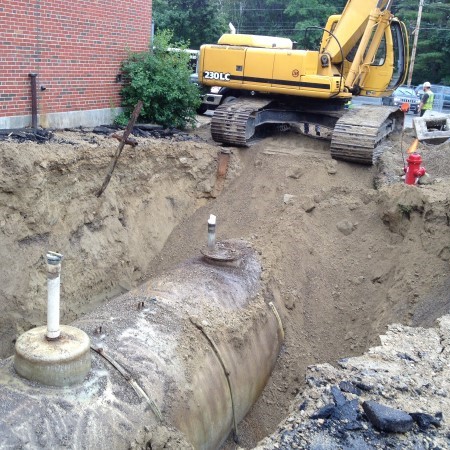 The Petroleum Remediation Section (PRS) receives notifications from a responsible party (i.e., the facility owner or land owner) or person of knowledge when a petroleum or oil discharge to the land or groundwater is discovered meeting the conditions specified in Env-Or 604. These rules specify the required notification content, and timeframe based on the age and volume of the discharge.
The Petroleum Remediation Section (PRS) receives notifications from a responsible party (i.e., the facility owner or land owner) or person of knowledge when a petroleum or oil discharge to the land or groundwater is discovered meeting the conditions specified in Env-Or 604. These rules specify the required notification content, and timeframe based on the age and volume of the discharge. Typical sources of petroleum discharges include underground storage tanks (USTs), above ground storage tanks (ASTs), and home heating oil tanks.
Common types of petroleum include gasoline, fuel oil, kerosene, diesel, motor oil and motor fuel. Other types of oil include dielectric fluid, transformer fluid, hydraulic fluid or hydraulic oil. Based upon the discharge source and product, projects are categorized into LUST, LAST, OPUF, FUEL, ETHER, SPILL/RLS and IRSPILL projects.
- STEP TWO: Initial Response
-
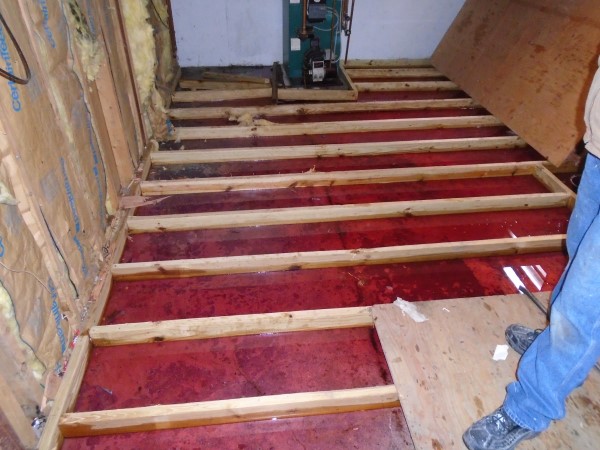 When there is an active release, such as from a tank or piping system containing petroleum; or damage to a home heating oil above ground storage system, Initial or Emergency Response actions may be necessary. The Initial Response is intended to stop the ongoing release and mitigate long term impacts by containing and cleaning up accessible petroleum before it seeps into the ground, or impacts groundwater. Initial response actions may not be necessary if the petroleum impacts encountered are the result of a past release discovered during site redevelopment or investigation.
When there is an active release, such as from a tank or piping system containing petroleum; or damage to a home heating oil above ground storage system, Initial or Emergency Response actions may be necessary. The Initial Response is intended to stop the ongoing release and mitigate long term impacts by containing and cleaning up accessible petroleum before it seeps into the ground, or impacts groundwater. Initial response actions may not be necessary if the petroleum impacts encountered are the result of a past release discovered during site redevelopment or investigation.For more information about Initial Response to petroleum spills and releases please visit the NHDES Spill Response page.
- STEP THREE: Site Investigation – Defining the nature and extent of petroleum contamination.
-
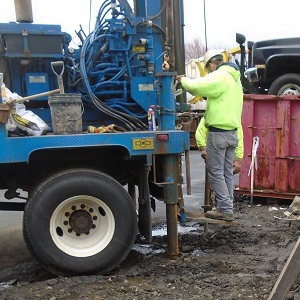 Once the immediate risk to human health and environmental threats are addressed, additional site investigations may be warranted to further define the nature and extent of contamination. The primary intent of the Site Investigation is to develop a Conceptual Site Model (CSM), upon which future regulatory decisions regarding remediation and additional assessment are based.
Once the immediate risk to human health and environmental threats are addressed, additional site investigations may be warranted to further define the nature and extent of contamination. The primary intent of the Site Investigation is to develop a Conceptual Site Model (CSM), upon which future regulatory decisions regarding remediation and additional assessment are based.A CSM is a narrative describing the occurrence and movement of groundwater and contaminants at the site including transport mechanisms, migration and degradation pathways, and potential receptors. Technical illustrations used to support the CSM narrative include maps and plans showing the lateral distribution of groundwater and soil contamination; cross-sectional plans showing the vertical extent of soil and groundwater contamination, as well as the subsurface geology to the extent that it is understood; and data tables comparing concentrations of contaminants of concern to the appropriate regulatory standards and/or screening levels.
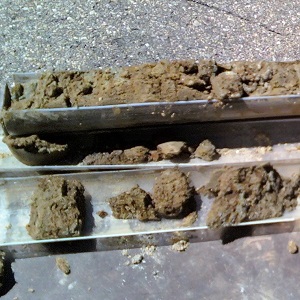 This additional information is gathered through: the installation of soil borings and groundwater monitoring wells; sampling, screening and/or analysis of soil, groundwater, drinking water, and indoor air samples; research of activities historically conducted at the site and vicinity that may have contributed to the contamination identified; and identification of potential human and environmental receptors of the documented contamination.
This additional information is gathered through: the installation of soil borings and groundwater monitoring wells; sampling, screening and/or analysis of soil, groundwater, drinking water, and indoor air samples; research of activities historically conducted at the site and vicinity that may have contributed to the contamination identified; and identification of potential human and environmental receptors of the documented contamination.Tools used to gather information for the CSM include, but are not limited to, installing monitoring wells and/or soil borings using various methods; online database research; and real-time technology, such as Laser-Induced Fluorescence (LIF) or other similar techniques to delineate Light Non Aqueous Phase Liquids (LNAPL). Bedrock fracture analysis can be determined using several borehole geophysics tools such as down-hole cameras, pressure inducers and temperature probes.
- STEP FOUR: Remediation – Eliminating or reducing the contamination that is the source of groundwater contamination.
-
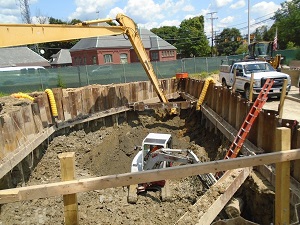 Data gathered during the site investigation phase(s) are used for determining the remedial strategy to eliminate or reduce the contamination source to groundwater. A remedial strategy may consist of one remediation technique or a series of techniques implemented over a specified timeframe. Common remediation techniques include soil excavation, soil vapor extraction (SVE), soil vapor extraction with air sparge (SVE/AS), in-situ chemical oxidation (ISCO), groundwater extraction and treatment through mechanical, chemical or biological means, and dual phase extraction. If, during an investigation, a drinking water source is determined to be contaminated above Ambient Groundwater Quality Standards (AGQS), then a Point-of-Entry treatment system (POE or POET) is installed to reduce the contamination to below the AGQS.
Data gathered during the site investigation phase(s) are used for determining the remedial strategy to eliminate or reduce the contamination source to groundwater. A remedial strategy may consist of one remediation technique or a series of techniques implemented over a specified timeframe. Common remediation techniques include soil excavation, soil vapor extraction (SVE), soil vapor extraction with air sparge (SVE/AS), in-situ chemical oxidation (ISCO), groundwater extraction and treatment through mechanical, chemical or biological means, and dual phase extraction. If, during an investigation, a drinking water source is determined to be contaminated above Ambient Groundwater Quality Standards (AGQS), then a Point-of-Entry treatment system (POE or POET) is installed to reduce the contamination to below the AGQS. Once a remediation evaluation is completed and approved, the remediation strategy is implemented. The site investigation phase and remediation strategy development phase constitute an iterative process, and additional information gathered during each phase may help to refine the remediation strategy.
A remediation strategy may include instituting an activity and use restriction (AUR) or institutional control to eliminate a direct contact pathway for any remaining contaminated soil. For petroleum contaminated sites, AURs are applicable when the remaining impacted soil is contaminated with PAHs above their respective soil remediation standards. The AUR must be recorded in the chain of title for the property where the AUR is instituted and requires periodic, typically every five years, self-certification by the land owner or responsible party.
- STEP FIVE: Groundwater Monitoring – Providing ongoing information about groundwater conditions at contaminated sites.
-
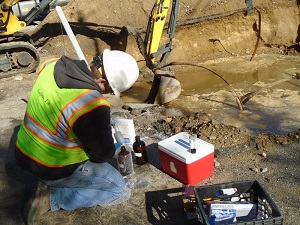 Once the sources to groundwater contamination are either eliminated or reduced to the extent practicable, a Groundwater Management Permit (GMP) is required to facilitate long-term monitoring at sites where the NHDES’s Ambient Groundwater Quality Standards are exceeded. GMPs establish specific enforceable requirements for periodic groundwater quality monitoring and reporting. The permit, as appropriate, may also include conditions that specify groundwater remediation, site investigation and/or remediation action plan requirements. Standards for groundwater quality are contained in Table 600-1 of NHDES’ Contaminated Sites Management rules under Env-Or 603.03. A notice stating that a GMP is issued must be recorded in the chain of title for each lot within a Groundwater Management Zone, which is established upon issuance of the GMP.
Once the sources to groundwater contamination are either eliminated or reduced to the extent practicable, a Groundwater Management Permit (GMP) is required to facilitate long-term monitoring at sites where the NHDES’s Ambient Groundwater Quality Standards are exceeded. GMPs establish specific enforceable requirements for periodic groundwater quality monitoring and reporting. The permit, as appropriate, may also include conditions that specify groundwater remediation, site investigation and/or remediation action plan requirements. Standards for groundwater quality are contained in Table 600-1 of NHDES’ Contaminated Sites Management rules under Env-Or 603.03. A notice stating that a GMP is issued must be recorded in the chain of title for each lot within a Groundwater Management Zone, which is established upon issuance of the GMP. - STEP SIX: Site Closure – The end result of remediation, when all contamination has been eliminated.
-
Site closure occurs when all regulated soil and groundwater contaminants have been eliminated or reduced to levels where they no longer represent a significant risk to human health or the environment, as specified in Env-Or 606.19 and 603.01, respectively.
If soil, and seasonally and hydrogeologically representative groundwater conditions demonstrate that the respective New Hampshire Soil Remediation and Ambient Groundwater Quality Standards (SRS and AGQS) are met, a site can be considered for site closure. If there is an active groundwater management permit (GMP) for the site, or if there are regulatory oversight costs incurred by NHDES, both need to be resolved prior to site closure. Decommissioning of groundwater monitoring wells, while recommended is usually not required prior to site closure.
Regulatory site closure can only occur when the criteria specified in Env-Or 609.02 - Certificate of No Further Action are met. Briefly,
- All direct exposure to contaminants through dermal contact, ingestion and inhalation are eliminated.
- Any necessary activity and use restrictions are implemented.
- All sources of groundwater contamination are eliminated.
- On-site and off-site dissolved contamination meet the Ambient Groundwater Quality Standards.
- Recorded releases of recordation notices are on file.
- Any penalties or fines are paid and invoices associated with NHDES recoverable cost are paid.




